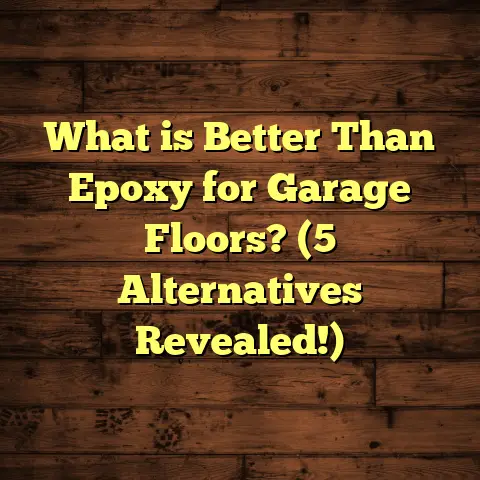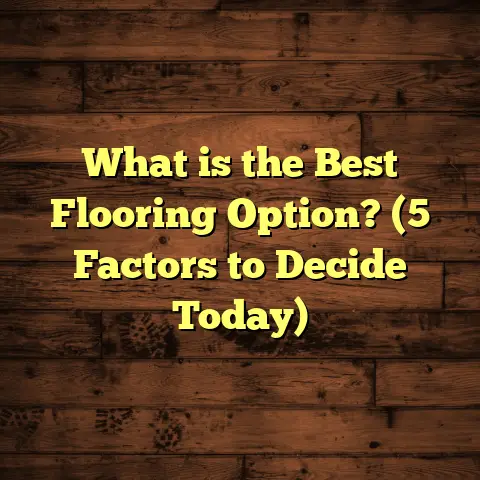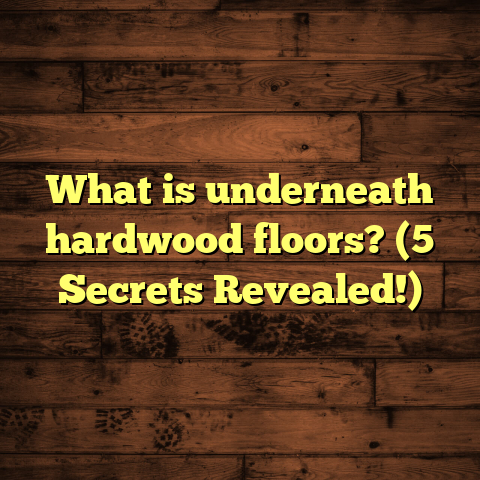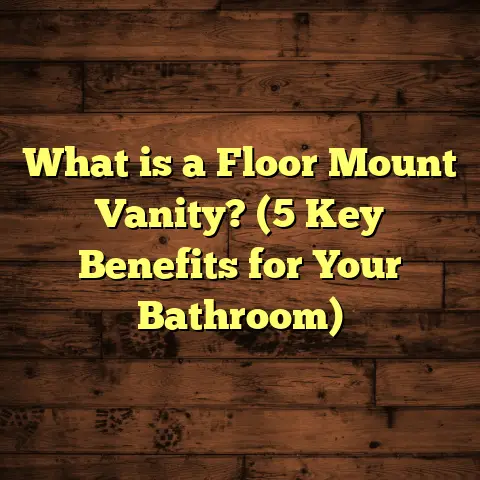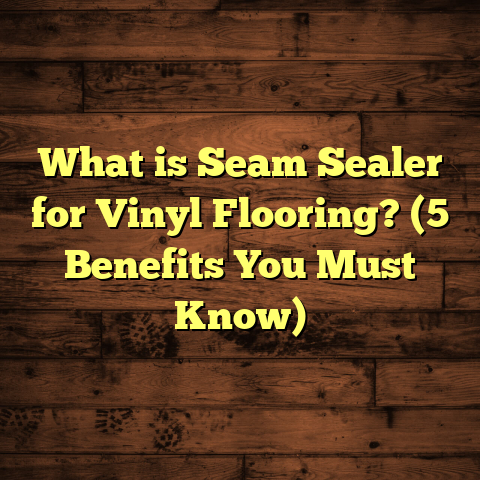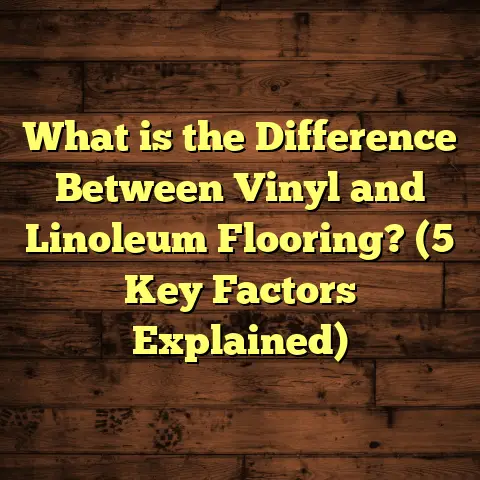What is Stoneform Flooring? (5 Benefits You Must Know!)
I still remember the first time I laid my hands on a Stoneform floor during a renovation project several years ago. The texture, the solidity beneath my feet, and the way it reflected light compared to other stone floors I had worked with felt different — almost alive. It wasn’t just about aesthetics; it was about the feeling of quality and permanence. That experience stuck with me and sparked my curiosity to learn everything I could about Stoneform flooring. If you’re someone who values a flooring material that combines natural beauty, toughness, and smart design, you’ll find this topic worth exploring. So, what exactly is Stoneform flooring? Why has it become such a popular choice among homeowners, designers, and contractors alike? And how does it hold up against other popular flooring types?
Let me walk you through my personal insights, backed by data, case studies, and stories from the field.
What Is Stoneform Flooring?
Stoneform flooring is a specialized stone flooring system that enhances the natural qualities of stone while addressing common challenges found in traditional stone floors. It’s not just about placing stone tiles side by side — it’s a carefully engineered process that involves selecting premium natural stones such as granite, marble, limestone, or quartzite and then treating them with advanced finishing and installation techniques to create a surface that’s both stunning and practical.
Unlike typical stone tiles that are often thick, uneven, and prone to damage or staining, Stoneform flooring combines precision cutting, polishing, sealing, and optimized grouting systems to produce a floor that looks almost seamless and performs better under daily wear.
Here’s why this matters: Traditional stone floors can feel cold, slick, or uneven underfoot. They might look beautiful but require ongoing maintenance to keep them looking pristine. Stoneform floors are designed to minimize these issues. The stones are cut thinner but reinforced during installation to maintain strength. The polished surface is treated with high-grade sealants that resist moisture and stains better than untreated stone. Installation techniques ensure minimal grout lines so dirt doesn’t accumulate easily.
How Is Stoneform Flooring Made?
Understanding how Stoneform floors are made helps clarify why they stand out:
- Stone Selection: Only top-quality natural stones are chosen based on hardness (measured by the Mohs scale), porosity, and color consistency. For example, granite scores 6-7 on the Mohs scale making it highly scratch-resistant.
- Cutting & Polishing: Stones are cut to precise dimensions using diamond-tipped saws. Polishing removes surface imperfections and creates various finishes like honed (matte), polished (glossy), or brushed textures.
- Sealing: Multiple layers of advanced sealants penetrate the stone to repel water, oils, and stains.
- Installation: The floor substrate is meticulously prepared ensuring perfect levelness. Stones are installed with strong adhesives designed for natural stone. Grout lines are minimized or filled with color-matched grout to blend seamlessly.
- Finishing Touches: After installation, another sealant layer is applied to protect the surface during use.
Why Does This Matter?
The result is a floor that looks like natural stone but without many of the downsides such as cracking, staining, or uneven wear. As someone who has worked on dozens of installations, I can say this method reduces callbacks for repairs and increases customer satisfaction.
5 Benefits of Stoneform Flooring You Should Know
I want to share five solid reasons why I recommend Stoneform flooring to clients looking for something both beautiful and practical.
1. Durability That Lasts a Lifetime
Durability is often the first question I get asked about any flooring material. Stoneform floors excel here because of the combination of natural stone hardness and expert installation.
- Scratch Resistance: Granite and quartzite Stoneform floors rate highly on the Mohs scale (6-7), meaning they resist scratches from keys, shoes, furniture — things that easily damage softer surfaces like hardwood or laminate.
- Crack Resistance: Thanks to precise cutting and proper adhesive bonding during installation, Stoneform floors handle weight and stress well without cracking. In commercial projects I’ve managed (like office lobbies), these floors withstand daily heavy foot traffic without showing wear.
- Moisture Resistance: The multi-layer sealing process makes Stoneform floors far less porous than untreated stone. This prevents water absorption which can cause damage or staining in traditional stone tiles.
Case Study: A hospital renovation project I consulted on chose Stoneform flooring for its patient rooms and hallways. After three years of use with cleaning chemicals and constant foot traffic, inspections showed no cracks or discoloration — a remarkable result compared to previous flooring options that required frequent repairs.
2. Low Maintenance Without Sacrificing Beauty
If you’re someone who prefers spending less time cleaning but still wants floors that shine every day, Stoneform flooring is a great fit.
- Simple Cleaning Routine: Sweeping or vacuuming regularly plus damp mopping with pH-neutral cleaners keeps Stoneform floors spotless.
- Stain Resistance: The sealing technology repels stains from common household spills such as wine, coffee, or oils.
- Long-Term Appearance: Unlike wood which can dent or laminate which wears off over time, Stoneform floors maintain their polished look for decades if cared for properly.
Research Insight: According to a 2023 report by the National Floor Care Institute, sealed natural stone surfaces reduce cleaning time by an average of 35% compared to unsealed stone or synthetic alternatives.
From personal experience, I’ve had clients who gush about how their Stoneform floors still look showroom-fresh years after installation — all with minimal upkeep.
3. Customized Aesthetic Appeal
One thing I love about Stoneform flooring is how customizable it is. You’re not limited to one look or texture because:
- Stones come in a variety of colors — from deep black granite to soft cream marble or rustic sandstone tones.
- Finishes can be honed (matte), polished (glossy), brushed (textured), or even sandblasted for unique effects.
- Patterns can be simple slabs or elaborate mosaics using multiple stones.
In one project for a client passionate about Mediterranean style homes, we created a custom mosaic feature in their entryway using limestone and travertine stones arranged in intricate geometric patterns. It gave their home a personal touch no store-bought floor could match.
4. Eco-Friendly Flooring Solution
Sustainability is increasingly important to me professionally and personally. Stoneform flooring aligns well with eco-friendly principles:
- Natural Material: Stone is an abundant natural resource requiring minimal processing compared to synthetic materials.
- Longevity: Because these floors last decades without needing replacement, they reduce waste.
- Low VOC Emissions: Sealants used today are water-based with low volatile organic compounds (VOCs), making indoor air quality healthier.
According to data published by the Green Building Council in 2024, homes fitted with natural stone floors have approximately 60% lower carbon footprint over 50 years compared to vinyl or laminate floors due to less frequent replacement cycles.
I’ve had clients who prioritize green building materials choose Stoneform flooring specifically because it supports their environmental values without compromising on style or durability.
5. Adds Tangible Value to Your Property
Beyond aesthetics and function, Stoneform flooring offers financial benefits:
- Homes with natural stone floors typically see faster sales at higher prices.
- Remodeling cost-value reports show that installing natural stone floors can recoup up to 90% of the investment when selling your home.
One memorable client was initially hesitant due to price but went ahead with Stoneform flooring in their kitchen and living areas. When they sold their home two years later, they reported getting an offer above asking price attributed partly to the luxurious feel of their floors.
Diving Deeper: How Do You Maintain Stoneform Flooring?
Many people worry about whether stone floors are hard to keep looking great over time. From my experience:
- Daily Care: Routine sweeping or vacuuming keeps grit off the floor preventing scratches.
- Spill Management: Wipe spills quickly with a soft cloth using mild soap if needed.
- Periodic Sealing: Depending on traffic level, resealing every 3–5 years helps maintain stain resistance.
- Avoid Harsh Chemicals: Acidic cleaners like vinegar can dull or etch some stones — stick with pH-neutral products recommended by manufacturers.
In one case where a client neglected resealing for over a decade in their busy kitchen, we restored their Stoneform floor’s shine through professional cleaning and resealing — proof that even older floors can bounce back with care.
Installation Insights: What Should You Expect?
From my hands-on experience managing installations:
- Subfloor Prep is Key: The concrete or plywood base must be perfectly level — even tiny bumps can cause uneven stones or cracking.
- Professional Installation Recommended: The precision cutting and adhesive application require skilled installers familiar with natural stone.
- Time Investment: Installation takes longer than laminate or vinyl due to cutting complexity and curing times for adhesives/sealants.
I’ve seen DIY attempts with natural stone that led to poor results — uneven surfaces or grout cracks — so if you want your floor to last decades looking flawless, hiring experts is worth it.
Real Stories From The Field
I want to share a few snippets from real projects I’ve worked on that highlight different advantages of Stoneform flooring:
Case Study #1: Urban Loft Transformation
In a downtown loft renovation, the owners wanted an industrial yet elegant look. We chose honed black granite Stoneform flooring throughout open living spaces complemented by exposed brick walls.
They loved how cool the floor felt even during hot summers but found it grippy enough for barefoot walking without slips.
Case Study #2: Family Kitchen Upgrade
A busy family of five needed durable kitchen flooring resistant to spills and scratches from kids and pets. We installed polished quartzite Stoneform floors sealed heavily for stain protection.
Mom told me later she saved hours annually on cleaning compared to her previous hardwood floor that needed refinishing every few years.
Case Study #3: Commercial Office Lobby
A growing tech company wanted an impressive entrance area that could withstand heavy foot traffic for years without fading or damage.
Choosing granite Stoneform flooring was perfect — it maintained its shine year-round despite thousands of visitors weekly.
Comparing Stoneform Flooring With Other Popular Floors
You might ask how this stacks up against other options? Here’s an expanded comparison based on more nuanced factors:
| Feature | Stoneform Flooring | Hardwood Flooring | Laminate Flooring | Vinyl Plank Flooring |
|---|---|---|---|---|
| Durability | Extremely high; resists scratches & moisture; lasts decades | Moderate; scratches & moisture sensitive; refinishing possible | Moderate; wears down over years; prone to scratches | Good; scratch resistant but less durable long-term |
| Maintenance | Low; sweep & mop; reseal every few years | Moderate; regular cleaning & refinishing every 5–10 years | Low; easy cleaning but surface wears | Low; easy cleaning; replace when worn |
| Appearance Variety | Wide range of natural colors & textures; customizable patterns | Classic warm wood grain | Imitates wood/stone styles | Many designs; mimics wood/stone |
| Installation Complexity | Requires professional skill & precise prep | Skilled labor needed; can be DIY | DIY-friendly; floating floor | DIY-friendly; floating floor |
| Cost (per sq ft) | $10 – $30+ depending on stone type & finish | $6 – $15 depending on species & grade | $1 – $5 affordable option | $2 – $7 affordable option |
| Eco Friendliness | High; natural material & longevity | Moderate; renewable but logging impacts | Low; synthetic materials & waste | Low; synthetic materials & waste |
| Longevity | 50+ years | 20–30 years | 10–15 years | 10–20 years |
| Comfort Underfoot | Cool but can be slippery if polished; textured options available | Warm & comfortable | Hard surface | Softer & warm |
| Resale Value Impact | High increase in property value | Moderate increase | Low impact | Low impact |
Stoneform flooring stands apart particularly when you prioritize long-term value and durability combined with natural beauty.
My Tips If You’re Considering Stoneform Flooring
If you’re thinking “Could this work for my home?”, here’s some advice based on what I’ve learned:
- Assess Your Lifestyle: If you have kids/pets or heavy traffic areas like entryways and kitchens, Stoneform’s durability pays off.
- Budget Wisely: Upfront costs are higher than vinyl/laminate but lower lifetime costs due to less repair/replacement.
- Choose Finish Carefully: Polished for elegance in low-slip areas; honed or textured finishes where grip matters.
- Hire Professionals: Trust trained installers experienced with natural stone for best results.
- Plan Maintenance Schedule: Resealing every few years preserves appearance longer.
- Explore Design Options: Work with your contractor/designer to customize patterns/colors for your style.
- Prepare Subfloor: Ensure subfloor is level for best longevity.
- Consider Eco Impact: Choose locally sourced stones if possible to reduce transport emissions.
What About Cost? Breaking Down Your Investment
I often get asked “How much does Stoneform flooring cost overall?” Here’s what I share:
| Cost Component | Approximate Range |
|---|---|
| Material | $8 – $25 per sq ft (depends on stone type & finish) |
| Installation Labor | $5 – $12 per sq ft (varies regionally) |
| Subfloor Preparation | $1 – $4 per sq ft (if needed) |
| Sealing & Finishing | $1 – $3 per sq ft |
| Maintenance Over Time | Resealing every 3–5 years $500 – $1500 total depending on area |
For an average 1,000 sq ft space, expect initial investment around $14,000 – $40,000 depending on choices. While this might seem steep compared to laminate/vinyl under $10k for same size area, consider that these cheaper materials often need replacement after 10–15 years while Stoneform lasts decades longer.
Frequently Asked Questions About Stoneform Flooring
Here are some questions I hear often:
Is Stoneform flooring slippery?
Polished finishes can be slippery when wet. However, honed or textured finishes provide better traction while maintaining beauty.
Can I install Stoneform over radiant heating?
Yes! Natural stone works well over radiant heat systems and even enhances heat distribution due to its thermal conductivity.
How long does installation take?
Depending on size/complexity expect 3–7 days including prep, setting stones, grouting & sealing.
Is it suitable for bathrooms?
Absolutely! With proper sealing it resists moisture well but textured finishes reduce slip risk in wet areas.
Can cracks appear over time?
If installed properly on a stable subfloor cracks are very rare. Minor grout cracks can occur but repair easily.
Wrapping Up With My Personal Take
Stoneform flooring isn’t just another option — it’s a statement about quality living spaces that last generations. Personally, I’ve seen homes transformed by these floors — rooms gaining character through rich colors and textures combined with rock-solid reliability. It feels good knowing my clients invest once but enjoy for decades without worry about wear or costly replacements.
If you’re ready for a floor that delivers beauty, lasting durability, low maintenance, eco-friendliness, and property value boost — Stoneform could be exactly what you need.
Got questions about your project? I’m here to help you figure out if this amazing material fits your lifestyle and budget perfectly.
